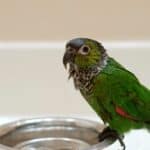Last Updated on January 29, 2024 by Carrie Stephens
Parrots can’t choose to alter the color of their feathers in the way lizards and frogs can. They can’t brighten or dim them, switch between colors, or introduce new patterns as camouflage.
Parrots’ plumage should be bright and colorful, denoting robust health. Regular preening with the beak keeps the feathers debris-free, properly aligned, and vibrant-looking.
Of course, parrots molt to accommodate growth and replace damaged feathers.
Molting is characterized by dull feathers and shedding inner (primary) feathers. The old, worn-out feathers should contrast sharply with the slowly emerging new ones.
Sick or diseased parrots’ feathers may turn gray, black, yellow, white, brown, or lose vibrancy. Dull and off-colored feathers may occur due to liver disease or a nutritional deficiency.
If a parrot is stressed or taking medication, its feathers may display banding (stress bars).
What Healthy Parrot Feathers Look Like
Healthy parrots’ feathers should have a single, unbroken shaft.
Feathers are often more than one color. This is due to psittacofulvins, which occur following the synthesis of polyketide synthase enzymes. These combine to create different hues in their plumage.
The feather itself should be glossy, and the barbs zipped together. The colors should be vibrant and clean, and the feathers should be soft to the touch.

Unhealthy Parrot Feather Appearance
Unhealthy parrots’ feathers have odd-looking, damaged, or drained colors, appearing:
- Ragged.
- Frayed.
- Ashy.
- Malformed.
- Bent.
- Broken.
- Oddly formed.
The feathers may be dry or brittle to the touch and combined with unusual patterns, like:
- Striping.
- Banding.
- Splotching.
Why Parrot Feathers Change Color
Here are the reasons why a parrot’s feathers may change color:
Maturity
A juvenile parrot’s feathers will change color as it grows and molts its down feathers.
The down feathers of most parrots are a mixture of whites and greys. As these soft, fluffy feathers are shed, they’ll be replaced with bright, strong, and sleek adult feathers.
The colors will match the tones for their species, aside from genetic mutations and normal variances.
A parrot’s feathers shouldn’t change after the down is lost, except if the following apply:
Health
Illness or nutritional deficiencies can cause markers on the feathers, such as:
- Stripes or banding.
- Blotches of discoloration.
- Faded sections.
Various health issues can cause a parrot’s feathers to change color, including:
- Stress.
- Diabetes mellitus.
- Psittacine beak and feather disease (PBFD).
- Fatty liver disease (hepatic lipidosis).
Nutritional deficiencies interfere with the body’s production of pigments and feathers. These deficiencies can be caused by a lack of vitamin A (hypovitaminosis A), sunlight, or calcium carbonate.
Too much dietary fat can also cause the feathers to darken gradually.
Feather Follicles
Feather follicles are delicate, so damage or continued irritation can interfere with regrowth.
The feather can be deformed, restricting the ability to reflect light. When the nanostructures are malformed, colors like blue become dim. Even a slight deformation can result in color loss.
While many factors can damage the follicles, feather-destructive behavior (feather plucking) is the most common explanation. Feathers removed aggressively can cause irreversible damage.
Trauma can cause follicle inflammation or infection. If a parrot is injured, that patch may not recover.
Molting
As a feather reaches the end of its lifespan, it may have a frayed appearance with duller colors.
The molting process allows old feathers to be shed and new feathers to replace them. Depending on the species, parrots molt 1-3 times a year. Smaller birds molt more frequently than larger birds.
How Parrot Feathers Change Color
Parrots don’t naturally change colors. Instead, they grow into their colors as they age.
All feathers contain pigments, which is called chemical coloring. They’ll react to the hormones and chemicals in the body as they mature. The pigments may change hue or become new colors.
According to Cell, parrots’ feathers contain pigments called psittacofulvins. The vivid red, orange, and yellow pigments are found only in parrot species.
Colors in parrots’ feathers are modified by light reflection, called structural coloring.
Most parrots have both structural and chemical coloring. For example, blue feathers aren’t created through pigments. Instead, they form due to the reflection of light in the nanostructures in each feather.
As most tones are affected by chemical balance, illness can impact the feathers. If malnutrition and stress occur, the structure of the feathers will be modified, so you’ll observe fraying and banding.
Parrot Feathers Turning A Different Color
There are reasons why a parrot’s feathers change to a specific color. Although not a hard-and-fast rule across all species, the new color may enable you to gauge the reason for the change.
Turning Black
Black and dark-colored feathers warn that the parrot has excess fat or protein.
A vitamin A deficiency can also cause black feather tips and edges.
Turning Yellow
Birds with fatty liver disease may develop bright yellow rather than black feathers.
Turning Brown
Parrots must bathe regularly because dirt and grime make the feathers look off-color or brown.
Check the parrot’s perches. Are they coated in feces and food waste? If so, clean the cage and everything inside. The waste is likely rubbing off onto the feathers, causing discoloration.
Turning Gray or Dull
A parrot’s feathers start to dull as it prepares to molt, which usually happens in the spring.
This results in the feathers turning gray or ashy. Parrot dust can also dull or gray out the natural vibrancy of a parrot’s plumage, making the feathers appear off-colored or white.
Shredded or Frayed
An illness or disease could lead to feathers growing back with markers or different colors.
African grays occasionally grow scattered red feathers throughout their plumage due to damaged follicles or medication. These feathers return to normal once they’ve finished molting.
Patches of off-colored, shredded, or damaged feathers may indicate an injury or infection in the skin or feather follicle. Parasites can also cause skin irritation, leading to over-preening or feather removal.

How To Improve Feather Quality
To enable a parrot to maintain healthy feathers, provide quality care. This includes:
Avoid Stress
Long periods of stress are responsible for feather banding, leading to behavioral problems and feather picking. A stressed parrot is likely unhappy, bored, lonely, annoyed, or jealous.
Position the cage in a room without much activity or noise, and ensure it’s large enough, with lots of engaging toys and enrichment items. If you make changes to the cage, do so gradually.
A well-socialized parrot will be happy and stress-free. Spend time with the parrot and allow it to join you in other parts of the house, such as having a perch in the living room.
Keep the cage away from air vents, fans, or air-conditioning to avoid drying out the feathers and skin.
Diet
While parrots eat specific foods for feather pigmentation, nutrition is crucial in maintaining healthy feathers. To promote feather growth, provide foods high in vitamin A, like:
Exercise
Preventing obesity and associated illnesses requires a balanced diet and ample exercise. A mentally enriched parrot is more active and unlikely to pick out feathers due to unhappiness.
Sunlight
Sunlight is vital for maintaining strong, vibrant, and healthy feathers.
Ensure that part of the cage is in an area with direct sunlight. This is needed for vitamin D3 synthesis, which is essential for absorbing minerals like calcium.
UVB lights are an alternative to sunlight, but they’ll cease producing UVB rays after 6 months.





